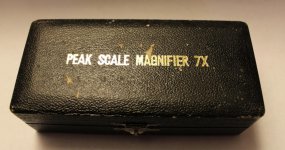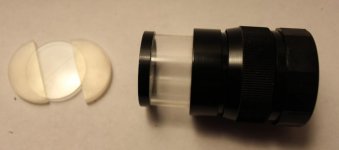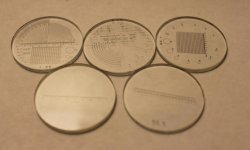Thornewmexico
Aluminum
- Joined
- Aug 11, 2011
- Location
- SW, USA
I purchased a used Peak inspection loupe at a local pawn shop. This loupe appeared of decent quality when originally made in Japan. It was in good condition except for greasy finger prints. The loupe came with five reticles, each with a separate protective plastic sleeve, and had intricate markings showing circle diameters, angles, length, grids, etc, in both inch and metric measuring systems. I was successful in cleaning everything except for the engraved reticles. I carefully exhaled on the first reticle, creating a fog on the reticle, and used a new / clean cotton swab with a gentle rubbing motion to clean it. A bunch of little black things appeared on the reticle and swab. It turns out these are the (?) dried ink markings which were in the engravings and which I had expertly rubbed off. The reticle appears to be made of glass on the basis of resistance to a knife blade applied to the edge and the ringing sound when gently dropped from half an inch onto a hard surface. In the portions where there is missing ink, I can see an engraving depression suggestive of some kind of precision engraving process, which further suggests to me the blackness was not merely stamped on. This de-inking occurred to the first of the five reticles I attempted to clean, so I left the other four reticles alone. The de-inked engraving markings are sort of visible when the loupe is used in good light, but not nearly as clearly seen as the ones with ink in them. Please see the pictures.
Questions: How should I have cleaned this? How can I re-ink the graduations to restore them, or how can I re-ink them to make them at least usable? Bonus question: What is the best way to mark engraved graduations / markings for best visibility on things like metal or plastic dials?
I chose this forum as opposed to the antique, metrology or general forums because it seemed the best fit to me, but if I judged wrong, please feel free to move it to a better forum.
Questions: How should I have cleaned this? How can I re-ink the graduations to restore them, or how can I re-ink them to make them at least usable? Bonus question: What is the best way to mark engraved graduations / markings for best visibility on things like metal or plastic dials?
I chose this forum as opposed to the antique, metrology or general forums because it seemed the best fit to me, but if I judged wrong, please feel free to move it to a better forum.









